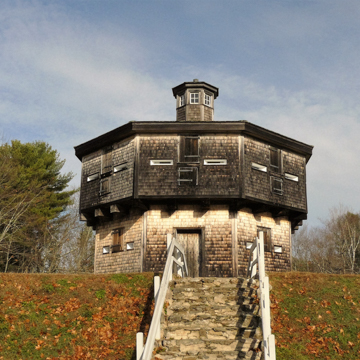Located on Davis Island at the narrows of the Sheepscot River, Fort Edgecomb, together with many other Maine forts, reflects the state’s strategic role in the nation’s coastal defenses. Between 1670 and the end of the nineteenth century, Maine constructed forts both small and large along its extensive coastline. Some have survived in memory, like Pentagoet, and some in ruins. Others have been extensively rebuilt (Fort Knox and Fort William Henry). But a number have stood the test of time, including Fort Edgecomb.
Octagonal in form, commanding the narrows of the Sheepscot as it approaches Wiscasset, Fort Edgecomb sits high at the center of a star-shaped earthworks. At the water level, massive stone revetments or batteries holding 18-pounder cannons provided fire across the Sheepscot River. A brick magazine with vaulted roof was buried beneath the eastern bastion. Above these lower batteries were crescent-shaped earthworks protected by a cannon, and above this, the two-story, octagonal-style, post-and-beam fortress. The fortress was sheathed in shingles with the upper story overhanging the first. The wooden blockhouse was originally covered with white plaster. However, there is evidence that it has been shingled (as it is today) as long as anyone can remember.
The earliest Maine forts, such as Pentagoet (1670), William Henry (1692), Halifax (1754–1755), and Pownall (1759), were mainly wooden blockhouses that sat at the apex of star-shaped earthworks. Fort William Henry at Pemaquid was a great round-shaped bastion. Most of Maine forts were built in the late eighteenth and early to mid-nineteenth centuries to defend the young nation, first from British and French invasions during the Napoleonic Wars and then during the Civil War. Three massive, largely intact, nineteenth-century stone fortresses guard strategic estuaries on the Maine Coast.
While hardly majestic like Knox and Gorges, Fort Edgecomb’s fame derives from the integrity of its original wooden blockhouse form. It is the oldest wooden blockhouse fort in the United States. In 1808, seeking to protect the important shipping port of Wiscasset from British warships, the United States purchased land on Davis Island in the Sheepscot River from Moses Davis. On May 30, 1804 Major Moses Porter, U.S. Army engineer, laid out the 3-plus-acre site for “military works,” and in August, Secretary of the Army Henry Dearborn gave directions for building the batteries that were completed in 1809. By March 24, 1809, guns were mounted; however, they were to be fired only once—for the inauguration of President James Madison.
Owned and operated by the Maine State Parks and Recreation Commission, the Fort Edgecomb State Historic Site is located minutes from Wiscasset, and is easily accessible and regularly open to the public.
References
Bradley, Robert L. The Forts of Maine, 1607-1945.Augusta: Maine Historic Preservation Commission, 1981.
Holmstrom, Donald, “Fort Edgecomb Memorial,” Lincoln County, Maine. National Register of Historic Places Inventory–Nomination Form, 1969. National Park Service, U.S. Department of Interior, Washington, D.C.

















